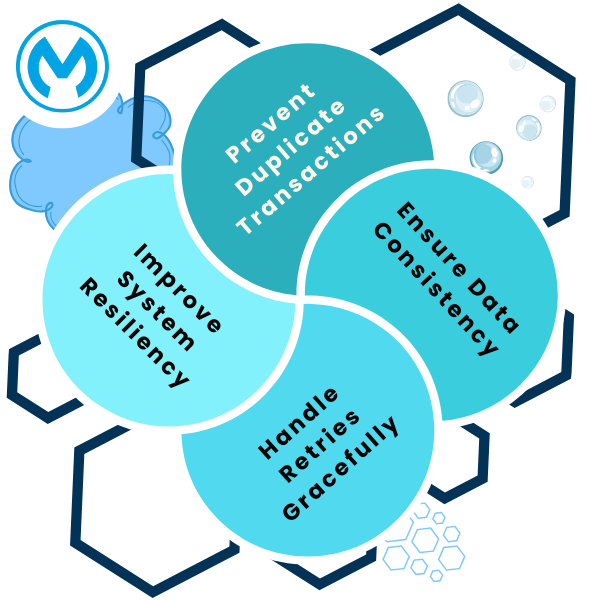Think of it like pressing the ‘Close Door’ button in an elevator, no matter how many times you press it, the door only closes once.
It was a quiet afternoon in the office, and the integration war room was buzzing with the usual energy. Vikas and Sneha, two solution engineers specialising in MuleSoft, were wrapping up their analysis of a complex integration scenario for a retail banking client.
“Vikas, do you ever feel like idempotency is one of those topics we talk about a lot but don’t fully appreciate until something breaks?” Sneha asked, sipping her coffee.
Vikas chuckled. “You mean until we’re buried in logs, trying to figure out why a service processed the same message three times and charged the customer thrice? Yeah, I’ve been there.”
The conversation that followed was not just a discussion, it was a deep dive into why idempotency is a cornerstone of successful enterprise integration.
What is Idempotency in Integration?
Sneha began, “Let’s start with the basics. Idempotency is about ensuring that a system produces the same result even if the same request is processed multiple times. Think of it like pressing the ‘Close Door’ button in an elevator, no matter how many times you press it, the door only closes once.”
Vikas nodded. “Exactly. And in enterprise integration, especially with tools like MuleSoft, idempotency ensures that retries, duplicate messages, or system failures don’t cause inconsistent or unintended outcomes.”
Importance of Idempotency
“Do you remember that payment integration we did last year?” Vikas asked. “The one where duplicate transaction processing nearly brought down the system?”
Sneha nodded. “Oh, yes. That was a mess. The payment gateway didn’t have idempotency keys, and every retry from the middleware was treated as a new transaction.”
Vikas leaned forward. “Exactly. And MuleSoft had to step in as the intermediary, using its Idempotent Filter to ensure that only unique messages were processed downstream. That’s when I truly realized how critical idempotency is.”
Idempotency in MuleSoft Integrations
Sneha and Vikas listed out the reasons
Preventing Duplicate Transactions
Sneha explained, “In retail banking or e-commerce, duplicate transactions can lead to overcharges, unhappy customers, and regulatory penalties. Idempotency ensures that even if a message is accidentally resent, it won’t result in duplicate processing.”
Handling Retries Gracefully
Vikas added, “Retries are inevitable in distributed systems. Network glitches, timeouts, or temporary system unavailability can cause middleware to retry messages. Without idempotency, retries can wreak havoc.”
Ensuring Data Consistency
Sneha continued, “Think about batch jobs processing large datasets. If the same batch is processed twice, it could corrupt the database or skew analytics. Idempotency safeguards against such errors.”
Improving System Resilience
Vikas summed it up, “Idempotency isn’t just a technical feature—it’s a resilience strategy. It ensures that systems behave predictably, even under unpredictable circumstances.”
How MuleSoft Enables Idempotency
Sneha pulled up her laptop and showed Vikas a MuleSoft implementation diagram.
“MuleSoft has built-in features that make it easier to implement idempotency, like”
- Idempotent Filter which ensures that duplicate messages are identified and filtered out based on unique keys.
- Caching Strategies helps storing processed request IDs in memory or a database for comparison.
- Persistent Object Stores where MuleSoft’s object store can maintain a record of processed requests to handle even long-running processes.
Vikas added, “And don’t forget how MuleSoft’s API-led connectivity model promotes idempotency at multiple levels. For instance, in system APIs, we can design idempotent endpoints that reject duplicate calls based on transaction IDs.”
Payment Processing with Idempotency
“Let’s sketch out a quick use case,” Sneha suggested.
The Scenario is that A customer initiates a payment via a mobile app. The middleware processes the request and sends it to the payment gateway.
The problem is that the mobile app sends the request twice due to a slow network.
Without Idempotency
- The payment gateway processes both requests, resulting in two deductions from the customer’s account.
- The customer service team receives complaints, refunds are issued, and trust in the brand erodes.
With Idempotency in MuleSoft
- MuleSoft’s Idempotent Filter identifies the duplicate request using the transaction ID.
- Only the first request is sent to the payment gateway, ensuring no duplicate charges.
“That’s the magic of idempotency,” Vikas said. “It’s not just about avoiding errors, it’s about building trust and reliability into the system.”
Integration Professionals must understand
Their conversation turned reflective as they considered the broader lessons.
- Idempotency is Non-Negotiable
Vikas emphasized, “For any critical integration, especially those involving financial transactions or customer data, idempotency isn’t optional. It’s a must-have.” - Design for Idempotency Early
Sneha added, “It’s easier to build idempotency into your system during the design phase than to retrofit it later. Think about idempotency keys, message uniqueness, and retry handling upfront.” - Leverage Middleware Capabilities
“Tools like MuleSoft make implementing idempotency manageable,” Vikas said. “Use the platform’s features wisely to reduce complexity.”
Test for Edge Cases
Sneha concluded, “Always test how your system handles duplicates, retries, and failures. Edge cases are where most integration issues surface.”
You know, idempotency isn’t just a technical feature—it’s a promise to our users. It’s how we ensure their trust in the systems we build.
The two engineers returned to their desks, their conversation a reminder that behind every seamless integration lies a commitment to principles like idempotency, principles that ensure systems are reliable, resilient, and ready for the real world.

